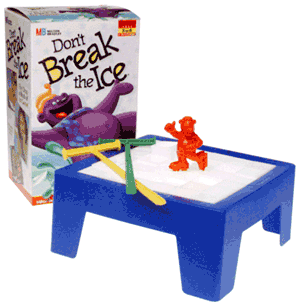Don't Break the Ice Game
Don't Break the Ice
 A polar bear is happily skating across the ice. He's gesturing thumbs up. A big smile stretches his face. Uh-oh. What's that tapping sound? A block of ice just disappeared from his pond. And there goes another one. The polar bear is running out of room to skate. In Don't Break the Ice, two to four players take turns wielding plastic mallets and tapping out ice blocks. The goal is to keep the polar bear skating for as long as possible. But as the game progresses, ice blocks start falling faster and faster. And then, there goes the bear! Luckily, these ice blocks don't melt. The game can quickly be reassembled and soon the polar bear is skating again. This bear might lose his footing, but he's always got his smile.
A polar bear is happily skating across the ice. He's gesturing thumbs up. A big smile stretches his face. Uh-oh. What's that tapping sound? A block of ice just disappeared from his pond. And there goes another one. The polar bear is running out of room to skate. In Don't Break the Ice, two to four players take turns wielding plastic mallets and tapping out ice blocks. The goal is to keep the polar bear skating for as long as possible. But as the game progresses, ice blocks start falling faster and faster. And then, there goes the bear! Luckily, these ice blocks don't melt. The game can quickly be reassembled and soon the polar bear is skating again. This bear might lose his footing, but he's always got his smile.
The Endearing Fascination Children Have with Polar Bears
Polar bears hold a special place in the hearts of children, captivating their imaginations and sparking a sense of wonder. The love for polar bears among children can be attributed to several endearing qualities and factors:
- Iconic Appearance: The majestic and distinct appearance of polar bears, with their thick white fur and black noses, makes them instantly recognizable and visually appealing to children.
- Affinity for Cold Climates: Children are often intrigued by the idea of animals thriving in extreme environments. The polar bear's ability to survive in the icy Arctic regions captures their curiosity and admiration.
- Gentle Demeanor: Despite their size and strength, polar bears are often depicted as gentle and affectionate creatures in children's literature and media. This portrayal fosters a sense of empathy and connection.
- Symbol of Wilderness: Polar bears symbolize the wild and untouched beauty of the Arctic wilderness. Children are drawn to their portrayal as powerful creatures living in harmony with nature.
- Playful Behavior: Videos and images of polar bear cubs engaging in playful activities, such as sliding on ice and swimming in the water, resonate with children's playful nature and sense of fun.
- Environmental Awareness: Education about the Arctic habitat and the challenges polar bears face due to climate change introduces children to concepts of conservation and environmental responsibility.
- Storytelling and Media: Books, animated shows, and documentaries featuring polar bears create relatable and endearing characters that children can root for and learn from.
- Soft Toys and Merchandise: Plush polar bear toys and merchandise offer a tangible connection to these creatures, allowing children to cuddle, play, and imagine adventures with their furry friends.
- Nurturing Instincts: The nurturing behavior of mother polar bears caring for their cubs resonates with children's understanding of familial bonds and care.
- Appeal of the Arctic: The mysterious and captivating nature of the Arctic region, with its icy landscapes and unique wildlife, adds to the allure of polar bears for children.
From their adorable appearance to the lessons they teach about nature and conservation, polar bears ignite children's curiosity, empathy, and sense of adventure. The enduring love for polar bears among children showcases the profound impact animals can have on young minds and their connection to the natural world.
